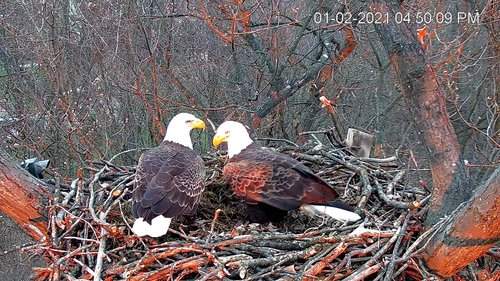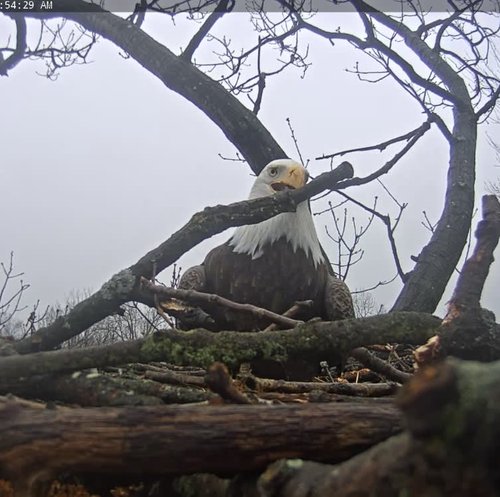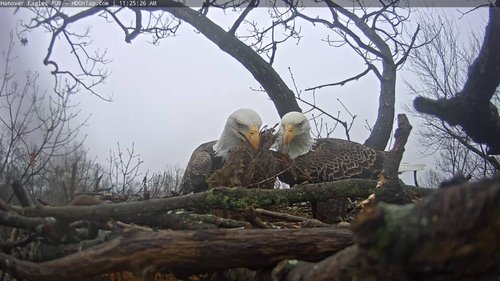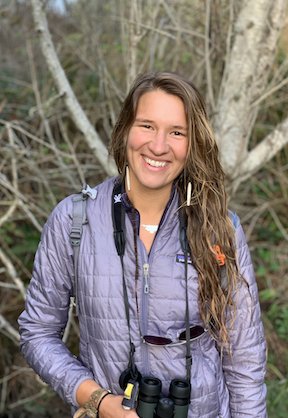Hanover Bald Eagle Blog # 1 - 2021
In partnership with Pennsylvania Game Commission and Comcast Business .

The Hanover eagles have been seen frequenting the PA nest many times this nesting season. The male was first spotted early September 2020.
This season, as we welcome the Hanover eagles home, we also extend a warm greeting to our returning Raptor Ecology Specialist Zoey T. Greenberg, and a new member of our team! Kate Alexander is our new Marketing and Social Media associate, and we are thrilled to welcome her onboard. Through careful observation and development of educational materials, Kate and Zoey will help contextualize the day-to-day activities at the Hanover nest.
Speaking of the nest, you may be wondering what we’ve noticed so far this season.
Over the last month and a half, the eagle pair have been hard at work modifying their nest’s Feng Shui and structural integrity. Through careful positioning of sticks and substrate, these two seasoned parents continue to demonstrate an eye for detail and an instinctual understanding of how a successful nest should be constructed.
Eagle nests are often referred to aeries, a Medieval Latin and Old French word meaning “nest” or “lair,” that referred to particularly high dwellings on cliffs or mountains. The word is fitting for eagle nests, since they are often visible from great distances due to their high positioning at the top of robust trees, and their impressive size.

The female eagle seen here meticulously moving around a stick for perfect placement within the structure of the nest.
Although bald eagles exhibit site fidelity - returning to the same site in consecutive years - they must reassess key criteria: Is the nest strong enough to support the nestlings? Is it sheltered from the elements? Protected from access by ground-dwelling predators? Easy to fly into? Do they have a far-reaching view of their surroundings? Given these complex criteria, new parents understandably make mistakes, which is why young bald eagles commonly practice building nests before they are ready to breed. This eagle couple, however, are experienced nesters.
The Hanover nest materials appear similar to those used last season, being composed primarily of straw, grass, and other adequately cushioning substances that will provide warmth and protection for the young. Eagle parents carve out a depression for the eggs to sit in, called the bole, and line it with soft materials such as their own downy feathers. The base layer of the nest is composed of interwoven sticks, which provide the necessary stability for a family of very large birds (together, the female and male eagle weigh at least twenty pounds).
It is therefore no surprise that the heartiest and largest conifers are often selected for nest building. In the absence of conifers, deciduous species such as oaks, hickories, and cottonwoods may be chosen. Nests are usually built in the top quarter of the tree, where the branches are thickest, and strong enough to hold a structure that could end up surpassing a weight of 1,000 pounds. The largest nest ever discovered was in Florida, measuring at nearly 10 feet across, 20 feet deep, and estimated at over 4,000 pounds.

As pictured above, the eagles often deliver soft materials like leaves, hay and pine needles into the center of the nest in preparation for laying eggs and nesting season.
Interestingly, not all bald eagles build nests in trees. In Pennsylvania it’s the norm, however in treeless regions like parts of Alaska and islands off the California coast, bald eagles may nest on the ground. Even then, they still look for places that provide protection from predators and flight accessibility for adults returning to the nest.
The Hanover eagles have been working on their aerie, or nest, in close quarters, demonstrating impressive cohabitation and reminding us that no matter how much space someone takes up at home, maintaining relational harmony pays off. Even when the male brings in a sub-par stick, they work it out. Nest modifications are likely part of the courtship process, even for established pairs. Working together to ready their home may help them strengthen their bond.
As we continue to observe these soon-to-be-parents, we will keep our eyes peeled for new behaviors. Stay tuned for our weekly blogs to learn more about the fascinating lives of breeding bald eagles!
ATTENTION HANOVER EAGLE VIEWERS - We recognize that over the years this bald eagle pair has been named by the public and is commonly referred to as "Freedom" and "Liberty". While we understand that naming the eagles helps connect viewers to the pair and distinguish the female from the male eagle, naming the pair introduces an element of domesticity to wild animals. In order to respect the eagles and focus on their natural history, we will refer to the female as "female" and "male" as recommended by the Pennsylvania Game Commission's team of biologists.
Sources:
Buehler, D. A. (2020). Bald Eagle (Haliaeetus leucocephalus), version 1.0. In Birds of the World (A. F. Poole and F. B. Gill, Editors). Cornell Lab of Ornithology, Ithaca, NY, USA.
https://doi.org/10.2173/bow.baleag.01
Journey North (2019). Nest Building Facts.
https://journeynorth.org/tm/eagle/annual/facts_nest.html
Merriam-Webster (n.d.). aerie. In Merriam-Webster.com dictionary. Retrieved December 14, 2020, from
https://www.merriam-webster.com/dictionary/aerie
Wright, Jim (2015). An Anecdotal History of Bald Eagle Nests in America. Duke Farms.
https://www.dukefarms.org/footer/blog/an-anecdotal-history-of-bald-eagle-nests-in-america/

RETURN TO HANOVER BALD EAGLE BLOGS
WATCH THE HANOVER BALD EAGLE LIVE CAMS
For over 20 years, HDOnTap has provided live streaming solutions to resorts, amusement parks, wildlife refuges and more. In addition to maintaining a network of over 400 live webcams, HDOnTap specializes in design and installation of remote, off-grid and otherwise challenging live streaming solutions. Contact press@hdontap.com for all media needs, including images and recordings.